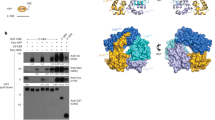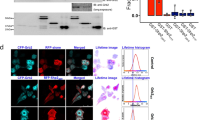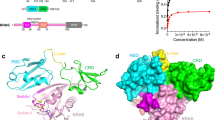Abstract
MANY tyrosine kinases, including the receptors for hormones such as epidermal growth factor (EGF), nerve growth factor and insulin, transmit intracellular signals through Ras proteins1–4. Ligand binding to such receptors stimulates Ras guanine-nucleotide-exchange activity5–9 and increases the level of GTP-bound Ras10–12, suggesting that these tyrosine kinases may activate a guanine-nucleotide releasing protein (GNRP). In Caenorhabditis elegans and Drosophila, genetic studies have shown that Ras activation by tyrosine kinases requires the protein Sem-5/drk, which contains a single Src-homology (SH) 2 domain and two flanking SH3 domains13–15. Sem-5 is homologous to the mammalian protein Grb2, which binds the autophosphorylated EGF receptor and other phosphotyrosine-containing proteins such as Shc through its SH2 domain16,17. Here we show that in rodent fibroblasts, the SH3 domains of Grb2 are bound to the proline-rich carboxy-terminal tail of mSos1, a protein homologous to Drosophila Sos. Sos is required for Ras signalling18–20 and contains a central domain related to known Ras-GNRPs21–23. EGF stimulation induces binding of the Grb2-mSos1 complex to the autophosphorylated EGF receptor, and mSos1 phosphorylation. Grb2 therefore appears to link tyrosine kinases to a Ras-GNRP in mammalian cells.
This is a preview of subscription content, access via your institution
Access options
Subscribe to this journal
Receive 51 print issues and online access
$199.00 per year
only $3.90 per issue
Buy this article
- Purchase on Springer Link
- Instant access to full article PDF
Prices may be subject to local taxes which are calculated during checkout
Similar content being viewed by others
References
Mulcahy, L. S., Smith, M. R. & Stacey, D. W. Nature 313, 241–248 (1985).
Smith, M. R., DeGudicibus, S. J. & Stacey, D. W. Nature 320, 540–543 (1986).
Szeberenyi, J., Cai, H. & Cooper, G. M. Molec. cell. Blol. 10, 5324–5332 (1990).
Thomas, S. M., DeMarco, M., D'Arcangelo, G., Halegoua, S. & Brugge, J. S. Cell 68, 1031–1040 (1992).
Medema, R. H., de Vries-Smits, A. M. M., van der Zon, G. C. M., Maassen, J. A. & Bos, J. L. Molec. cell. Biol. 13, 155–162 (1993).
Zhang, K., Papageorge, A. G. & Lowy, D. R. Science 257, 671–674 (1992).
Burgering, B. M. Th. et al. EMBO J. 10, 1103–1109 (1991).
Li, B.-Q., Kaplan, D., Kung, H.-F. & Kamata, T. Science 256, 1456–1459 (1992).
Buday, L. & Downward, J. Molec. cell. Biol. 13, 1903–1910 (1993).
Gibbs, J. B., Marshall, M. S., Scolnick, E. M., Dixon, R. A. F. & Vogel, U. S. J. biol. Chem. 265, 20437–20442 (1990).
Satoh, T. et al. Proc. natn. Acad. Sci. U.S.A. 87, 7926–7929 (1990).
Qiu, M.-S. & Green, S. H. Neuron 7, 937–946 (1991).
Clark, S. G., Stern, M. J. & Horvitz, H. R. Nature 356, 340–344 (1992).
Olivier, J. P. et al. Cell 73, 179–191 (1993).
Simon, M. A., Dodson, G. S. & Rubin, G. M. Cell 73, 169–177 (1993).
Lowenstein, E. J. et al. Cell 70, 431–442 (1992).
Rozakis-Adcock, M. et al. Nature 360, 689–692 (1992).
Bowtell, D., Fu, P., Simon, M. & Senior, P. Proc. natn. Acad. Sci. U.S.A. 89, 6511–6515 (1992).
Simon, M. A., Bowtell, D. D. L., Dodson, G. S., Laverty, T. R. & Rubin, G. M. Cell 67, 701–716 (1991).
Bonfini, L., Karlovich, C. A., Dasgupta, C. & Banerjee, V. Science 255, 603–606 (1992).
Jones, S., Vignais, M.-L. & Broach, J. R. Molec. cell. Biol. 11, 2641–2646 (1991).
Lai, C.-C., Boguski, M., Broek, D. & Powers, S. Molec. cell. Biol. 13, 1345–1352 (1993).
Shou, C., Farnsworth, C. L., Neel, B. G. & Feig, L. A. Nature 358, 351–354 (1992).
Pelicci, G. et al. Cell 70, 93–104 (1992).
Cicchetti, P., Mayer, B. J., Thiel, G. & Baltimore, D. Science 257, 803–806 (1992).
Yu, H. et al. Science 258, 1665–1668 (1992).
Ren, R., Mayer, B. J., Cicchetti, P. & Baltimore, D. Science 259, 1157–1161 (1993).
Li, N. et al. Nature 383, 85–88 (1993).
Gale, N. W., Kaplan, S., Lowenstein, E. J., Schlessinger, J. & Bar-Sagl, D. Nature 363, 88–92 (1993).
Gross, E., Goldberg, D. & Levitzki, A. Nature 360, 762–765 (1993).
Moran, M., Polakis, P., McCormick, F., Pawson, T. & Ellis, C. Molec. cell. Biol. 11, 1804–1812 (1991).
Matuoka, K., Shibata, M., Yamakawa, A. & Takenawa, T. Proc. natn. Acad. Sci. U.S.A. 89, 9015–9019 (1992).
Author information
Authors and Affiliations
Rights and permissions
About this article
Cite this article
Rozakis-Adcock, M., Fernley, R., Wade, J. et al. The SH2 and SH3 domains of mammalian Grb2 couple the EGF receptor to the Ras activator mSos1. Nature 363, 83–85 (1993). https://doi.org/10.1038/363083a0
Received:
Accepted:
Issue Date:
DOI: https://doi.org/10.1038/363083a0
This article is cited by
-
GRB2 is a BECN1 interacting protein that regulates autophagy
Cell Death & Disease (2024)
-
GRB2 dimerization mediated by SH2 domain-swapping is critical for T cell signaling and cytokine production
Scientific Reports (2023)
-
Prediction of human protein interactome of dengue virus non-structural protein 5 (NS5) and its downstream immunological implications
3 Biotech (2023)
-
The dynamics of free and phosphopeptide-bound Grb2-SH2 reveals two dynamically independent subdomains and an encounter complex with fuzzy interactions
Scientific Reports (2020)
-
A SYK/SHC1 pathway regulates the amount of CFTR in the plasma membrane
Cellular and Molecular Life Sciences (2020)
Comments
By submitting a comment you agree to abide by our Terms and Community Guidelines. If you find something abusive or that does not comply with our terms or guidelines please flag it as inappropriate.



